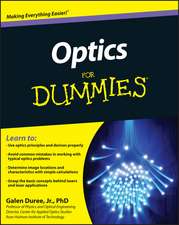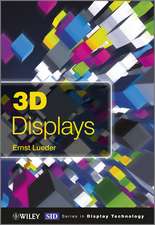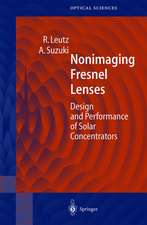Fundamentals of Electronic Imaging Systems: Some Aspects of Image Processing: Springer Series in Information Sciences, cartea 15
Autor William F. Schreiberen Limba Engleză Paperback – 19 feb 1993
Din seria Springer Series in Information Sciences
- 20%
 Preț: 337.66 lei
Preț: 337.66 lei - 18%
 Preț: 955.08 lei
Preț: 955.08 lei - 15%
 Preț: 646.62 lei
Preț: 646.62 lei - 20%
 Preț: 337.52 lei
Preț: 337.52 lei -
 Preț: 385.62 lei
Preț: 385.62 lei -
 Preț: 381.98 lei
Preț: 381.98 lei - 20%
 Preț: 324.64 lei
Preț: 324.64 lei -
 Preț: 380.84 lei
Preț: 380.84 lei - 18%
 Preț: 777.69 lei
Preț: 777.69 lei -
 Preț: 387.96 lei
Preț: 387.96 lei -
 Preț: 396.62 lei
Preț: 396.62 lei - 20%
 Preț: 330.75 lei
Preț: 330.75 lei -
 Preț: 382.57 lei
Preț: 382.57 lei - 15%
 Preț: 642.18 lei
Preț: 642.18 lei - 15%
 Preț: 640.06 lei
Preț: 640.06 lei -
 Preț: 387.58 lei
Preț: 387.58 lei - 20%
 Preț: 333.40 lei
Preț: 333.40 lei -
 Preț: 386.99 lei
Preț: 386.99 lei - 20%
 Preț: 653.71 lei
Preț: 653.71 lei - 15%
 Preț: 661.02 lei
Preț: 661.02 lei - 18%
 Preț: 1391.21 lei
Preț: 1391.21 lei - 15%
 Preț: 638.43 lei
Preț: 638.43 lei - 15%
 Preț: 642.68 lei
Preț: 642.68 lei -
 Preț: 386.00 lei
Preț: 386.00 lei - 20%
 Preț: 649.60 lei
Preț: 649.60 lei - 18%
 Preț: 950.21 lei
Preț: 950.21 lei -
 Preț: 393.35 lei
Preț: 393.35 lei - 20%
 Preț: 652.41 lei
Preț: 652.41 lei - 20%
 Preț: 645.65 lei
Preț: 645.65 lei -
 Preț: 390.25 lei
Preț: 390.25 lei -
 Preț: 387.96 lei
Preț: 387.96 lei - 15%
 Preț: 580.97 lei
Preț: 580.97 lei
Preț: 391.61 lei
Nou
Puncte Express: 587
Preț estimativ în valută:
74.94€ • 77.95$ • 61.87£
74.94€ • 77.95$ • 61.87£
Carte tipărită la comandă
Livrare economică 14-28 aprilie
Preluare comenzi: 021 569.72.76
Specificații
ISBN-13: 9783540560180
ISBN-10: 3540560181
Pagini: 356
Ilustrații: XIX, 332 p.
Dimensiuni: 155 x 235 x 19 mm
Greutate: 0.5 kg
Ediția:Softcover reprint of the original 3rd ed. 1993
Editura: Springer Berlin, Heidelberg
Colecția Springer
Seria Springer Series in Information Sciences
Locul publicării:Berlin, Heidelberg, Germany
ISBN-10: 3540560181
Pagini: 356
Ilustrații: XIX, 332 p.
Dimensiuni: 155 x 235 x 19 mm
Greutate: 0.5 kg
Ediția:Softcover reprint of the original 3rd ed. 1993
Editura: Springer Berlin, Heidelberg
Colecția Springer
Seria Springer Series in Information Sciences
Locul publicării:Berlin, Heidelberg, Germany
Public țintă
ResearchCuprins
1. Introduction.- 1.1 What is Image Processing.- 1.2 Descriptions of Images.- 1.3 Sources and Types of Images.- 1.4 Processing Images.- 1.5 Purposes of Processing.- 1.6 Image Quality.- 1.7 A Generalized Image Processing System.- 1.8 A Simple Television System.- 1.9 Lessons for the System Designer.- 2. Light and Optical Imaging Systems.- 2.1 Light Sources.- 2.2 Photometry.- 2.3 Luminous Transfer of Simple Optical Systems.- 2.4 Some Nonideal Behavior of Simple Optical Systems.- 2.5 Fourier Optics and the Modulation Transfer Function.- 2.6 Quantum Phenomena and Related Noise Sources.- 2.7 Lessons for the System Designer.- 2.8 Appendix: Statistical Considerations.- 3. Perception of Images.- 3.1 Seeing in the Dark.- 3.2 Contrast Sensitivity.- 3.3 The Effect of Shape.- 3.4 Masking.- 3.5 Temporal Phenomena.- 3.6 Lessons for the System Designer.- 4. Sampling, Interpolation, and Quantization.- 4.1 Introduction.- 4.2 The Sampling Theorem.- 4.3 The Two-Dimensional Spectrum.- 4.4 Interpolation of Digital Images.- 4.5 The Presampling Filter.- 4.6 Hexagonal Sampling.- 4.7 Quantization.- 4.8 Lessons for the System Designer.- 5. Compression.- 5.1 Introduction.- 5.2 Information-Preserving Coding.- 5.3 Graphics Coding.- 5.4 Coding of Continuous-Tone Images.- 5.5 Lessons for the System Designer.- 6. Image Processing in the Graphic Arts.- 6.1 Introduction.- 6.2 Type Composition.- 6.3 Modern Plate Making.- 6.4 The Halftone Process.- 6.5 Lessons for the System Designer.- Color.- 7.1 Color Matching.- 7.2 Color Mixtures.- 7.3 Numerical Colorimetry.- 73.5 The Nature of the CDE Primaries.- 7.4 Other Color Spaces.- 7.5 Additive Color Reproduction.- 7.6 Subtractive Color Reproduction.- 7.7 Color Editing.- 7.8 Color Coding.- 7.9 Some Experiments in Color Perception.- 7.10 Lessons for the System Designer.- 8. The Design of Improved Television Systems.- 8.1 A Review of TV Basics.- 8.2 Relevant Psychophysics.- 8.3 The 1941 NTSC System.- 8.4 Adding Color.- 8.5 NTSC System-Design Limitations.- 8.6 Compatible Improvements to NTSC.- 8.7 Designing from Scratch.- 8.8 Desirable Characteristics of a New System.- 8.9 Channel Considerations.- 8.10 Interference Considerations.- 8.11 Video Function Characteristics Useful for System Design.- 8.12 Some Specialized Video Signal-Processing Techniques.- 8.13 Digital Terrestrial Broadcasting.- 8.14 Some Sample System Designs.- 8.15 Lessons for the System Designer.- Appendix: Development of High-Definition Television in Japan, Europe, and the United States.- A1. Introduction.- A1.1 Compatibilityz.- A1.2 Spectrum Considerations.- A1.3 Alternative Transmission Channelsx.- A1.4 Transition Scenarios.- A2. Japan.- A2.1 History of the Japanese Developments.- A2.2 The “Studio” System.- A2.3 MUSE.- A2.4 Systems Specifically Designed for US Broadcast Use.- A2.4.1 Narrow MUSE.- A2.4.2 NTSC “MUSE”-6.- A2.4.3 NTSC “MUSE”-9.- A2.5 Conclusions: Japan.- A3. The United States.- A3.1 The FCC Inquiry.- A3.2 Orginially Proposed Systems.- A3.3 The General Instrument Proposal.- A3.4 Other Digital Proposals.- A3.5 Problems of All-Digital Systems.- A3.6 Conclusions: United States.- A4. Europe.- A4.1 Multiplexed Analog Components.- A4.2 Overall European Strategy.- A4.3 Technological Approach.- A4.4 Three-Branch Motion Compensation.- A4.5 Implementation of D2-MAC and HD-MAC.- A4.6 PALplus.- A4.7 Digital Television in Europe.- A4.8 Conclusions: Europe.- A5. Overall Conclusions.- References.











